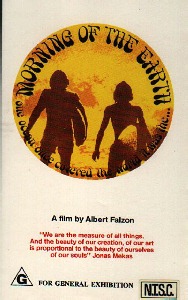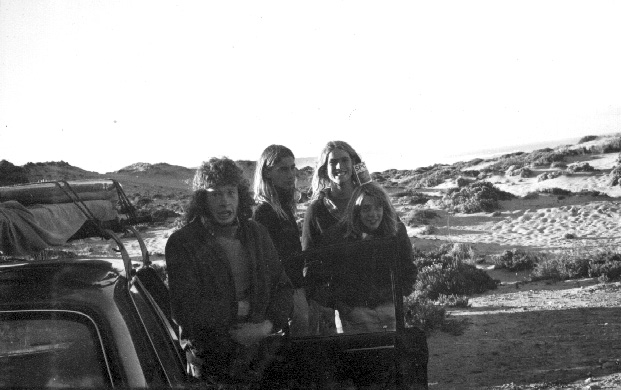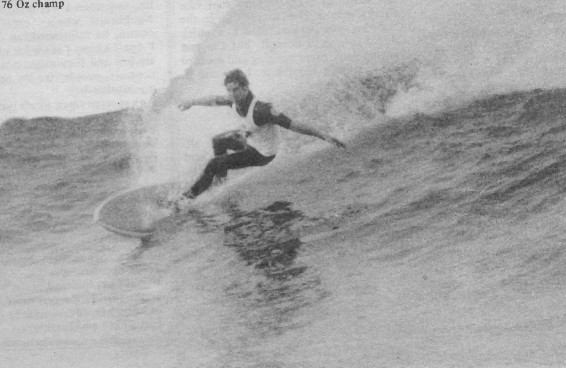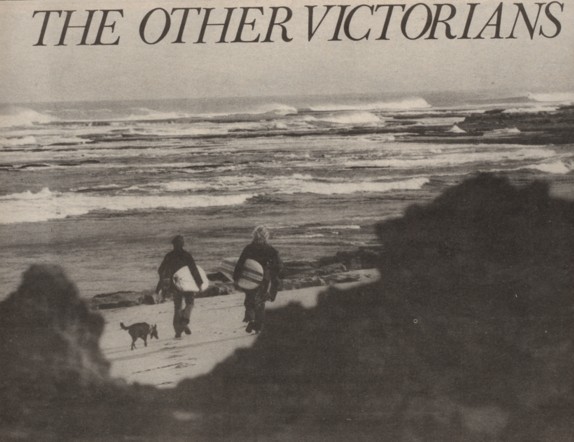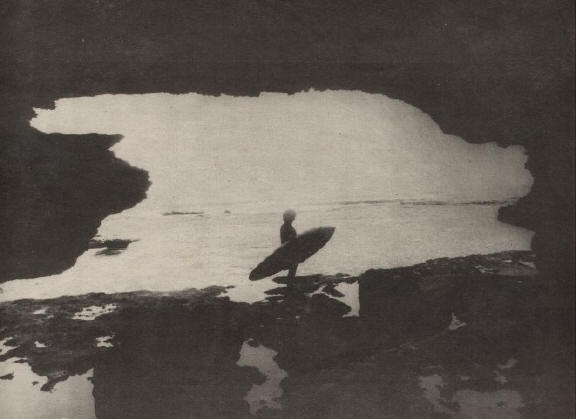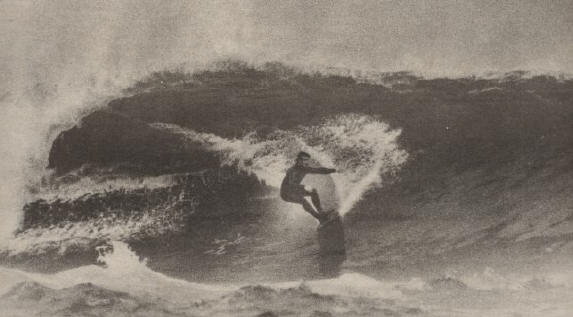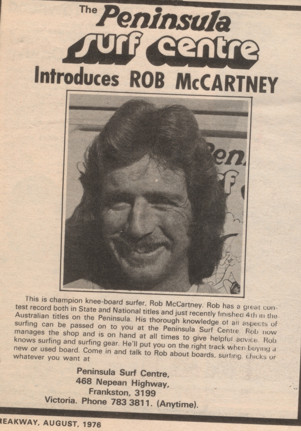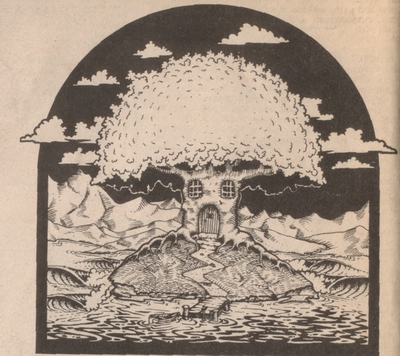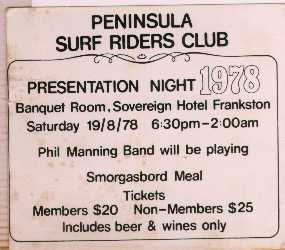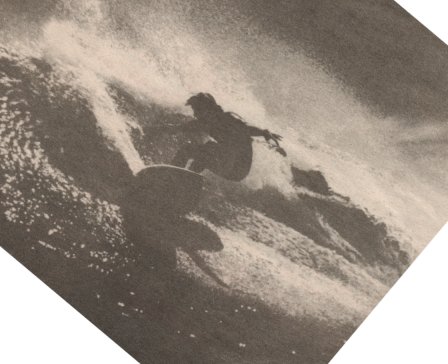The Seventies
The heady days of the 1970s: HD station wagons, flannelette shirts and sox with thongs, ah, smell that sweet sandalwood oil!
1970 - Trigger Brothers Surfboards established. The shop at Chelsea followed soon afterwards.
1971 - John Jolly and Dale Evans move down the coast, perhaps the first East Coast surfers to make that commitment. Some estimate that over the years John Jolly (he founded Shady Hollow and now glasses for Trigger Brothers) has surfed the Point more than any other human being.
1972 - Morning of the Earth released. Everything changes; fashion, music, board shapes...everything really. Yes, everything.
1974 - Peninsula Surfrider's Club formed, located mainly around Point Leo and Gunnamatta' this Club goes on under long time President Skip Easton to become the most successful boardriding club on the East Coast. Some of their champions included Pretzel, Ian Cochrane, Wally Tibbells and Mick Pierce. [I hope to get a full list here one day]
July 1974 - Point Leo 1200 Contest won by Phil Trigger. The 'shopkeeper's contest' (as Breakaway called it) is described in part below:
'On Sunday the swell was huge. The west wind was strong and came from the side. Off the point, there was 6 to 8 ft waves with an occasional 10 footer. It was the biggest Point Leo had been for months and the stage was set for some exciting riding in the finals
First in were the open finalists: Maurice Cole, Alan Atkins, Ian Portingale, Phil Trigger, Ross Slaven and myself (Ted Bainbrdidge). With board caddies close by we surfed those waves for an hour. They weren't particularly good, but they were big and the experienced riding of Phil Trigger, Alan Atkins and Maurice Cole really stood. out. It was a close battle for first place but Phil Trigger edged the other two out through local knowledge and longer rides.' (Breakaway, August 1974)
Results:
Open
1. Phil Trigger
2. Alan Atkins
3. Maurice Cole
4. Ted Bainbridge
5. Ian Portingale
6. Ross Slaven1974 - Mats are big in all the mags with Glenys Atkins writing an article in October 1974 'Breakaway' called 'It's all a matter of handling'. They were made by O'Neill and companies like 'Free N Easy' and cost around $23.95. First Reef was full of them for a time.
1974 - Rogues Gallery - Ted Bainbridge, Phil Trigger, Harry Hodge, Paul Trigger - From 'Breakaway' July 1974 (PSC advertisement)
1974 - Point Leo Surf Lifesaving Club burnt down in 'suspicious circumstances'
197- 'Breakaway' magazine established to document surfing on the Mornington Peninsula.
1975?s - The Davey's Bay boys at St Andrews before the houses arrived. From Left: Bluey, Warrick, Andrew, Harry (with SPC can on head)
1975 - The Point Leo 1200 spends most of its time at Portsea and was won by Bruce Raymond. Ted Bainbridge wrote in 'Breakaway':
'The most incredible manoeuver of the contest was done by Bruce Raymond in the open final, wo did a forehand, off the lip, freefall, sort of re-entry on a five foot righthander. Everyone on the beach couldn't believe it and he went on to win with controlled surfing on the mainly lefthand break.'
Results:
1 Bruce Raymond
2. Andrew McKinnon
3. Russell Lewis
4. Mick Pierce
5. Alan (Wally) Tibballs
6. Paul Trigger1975 - Harry Hodge's first film 'Liquid Gold' appears. Hodge talks about a right he filmed in Bali called SANUR, and said local shooting 'began on the cold wintry coast of Victoria where long walls and hollow tubes are plentiful to those brave enough to venture out . . . many times I was rewarded with good waves and good surfing by Paul and Phil Trigger, Ted Bainbridge, local goofy footer Mick Pierce and knee board rider Rob McCartney.' (Breakaway - July 1975)
1976 - Australian Titles held on the Mornington Peninsula beginning at a 'reasonable V-bank left' at 6' Gunna, which was to be the only left of the contest. On the Monday the contest is moved to Point Leo 'better known as the Slug Pit' (!) 'Claw explained the rudiments of riding the Pit, saying even though it breaks right, you must go left to turn right and if you cutback too much you'll bog down in the pit and miss the miraculous reform'. Later in the day, 'The swell seemed to be increasing out in Cat Bay and Seal's Rock off the tip of Phillip Island was producing a monster bombie. The first Open Semi-Final was the last event of the day and the tide had completely covered every square inch of rock. Mark Warren, determined to go for that extra length, surfed over bare reef, to the provocation of the crowd.' One local surfer to stand out during the week was Phil Trigger who 'won the hardest heat from Col Smith, PT, Ron Ford and Craig Betternay, in that order'.
During the week the contest was held at Pines for some time and Tracks was critical of Stan Couper's management of the even saying 'In summary the Nationals could have been a lot better in every way. There were better waves around at the time and besides Victoria is an arsehole of a place after Easter, weather-wise.'
Mark Warren attacking Point Leo during the 1976 Aussie Titles - [Photo: Martin Tullemans - Tracks - June 1976]
Australian Titles 1976 Results.
MENS
1. Mark Warren NSW
2. Peter Townend QLD
3. Wayne Bartholemew QLD
4. Ian Cairns WA
5. Steve Jones NSW
6. Simon Anderson NSW(Andrea - Tracks - June 1976)
The 1970s walk to the 'Station [Photo: Martin Tullemans - Tracks]
March 1976 - Tracks puts out an article on 'The Other Victorians which describes the surfing on the Mornington Peninsula, almost for the first time to a national audience. Written by Phil Jarratt, it opens with 'In my opinion that rotten, depressing, traffic-clogged three lane road (Nepean Highway) is the key to what the Mornington Peninsula is all about when you get to the end of it you're ready to surf anything.
Jarratt argues that 'the area is turning out Victoria's best surfers in spite of consistently lousy surf and weather' and describes it as the 'Kook Coast' Rob McCartney says, 'Gunnamatta always picks up swell. There's waves there all but three or four days a year. It may be terrible but there's waves and you can surf them. We haven't got a wave that can compare with Bells, but we've got lots of waves'.
Mick Parkinson, who 'makes surfboards in a shed behind his father's house in Blairgowrie' says memorably 'I dig the juice of the waves here. I've surfed all over the place in NSW and Queensland but the juice always brings me back. When you get tubed here you really know it.'
'The hole in the rocks that leads to Spooks' said the Tracks caption and that afro-style hair can only belong to a reckless young Mick Schaeffer [Photo Martin Tulleman. Tracks]
Mick Pierce on a cold grey day at Pumping Station - [Photo: Martin Tulleman - Tracks]
August 1976 - Rob McCartney introduced to the Breakaway Readership
1976 - The Oke Custom Surfboard Logo
PSC Ticket - Presentation Night 1978
April 1979 - Tracks revisits the Hoax Coast with its article 'There's more to Victorian than Bells Beach and the Torquay Pub' and lists some of the hot locals as: Unknown names like Wally Tibballs, Mick Pierece, Ted Bainbridge, Ian Cochrane, Phillip Coates, Mick Marchants, Ian Mulligan, Ronnie Roozen and the hot juniors Malcolm Luke and Ross Jamieson.'
The article describes Point Leo, local feuds between Phillip Island Boardriders Club and Peninsula Surfrider's Club and describes some of the breaks on the coast: 'On a good weekend, when a small swell pumps into Gunnamatta, the beach takes on a carnival atmosphere. Hot, fiery locals pack the waves giving a display of radical surfing comparable to anywhere in Australia. The bitumen car park resembles a mardi-gras indeed, during the recent Mohammed Ali world title fight, a few enterprising chaps displayed a rare flash of initiative when they rigged a portable TV on the roof of a Holden for a bit of diversion between sessions in the water.' It also describes Quarantine as the 'Peninsula's hollowest, fastest and meanest left-hander. When the swell hits the shallow section, it stands up vertical in an instant and steams off down the line in one big turn and go for it tube. One bad wipeout here and you start to re-assess your priorities in life; one five to six second tube and you're standing on top of the world hooting. It's high energy surfing at its peak'
Phil (Pretzel) Coates samples deep south cooking [Photo: Robert Hunt - Tracks 1979]
1979 -Various surfers leaving the pub are caught up in what becomes known as the 'Frankston Riot' The police report reads that 'the riot began between rival patrons from three hotels positioned on the three corners of one intersection in Frankston. At closing time, patrons from the three hotels came on to the road and commenced to fight and to cause damage to property. It was necessary for police to read the riot act and then to take action to disperse the mob.'
December 1979 - Tracks lists three Peninsula surfboard makers in their buying guide. Dave Morrison and Clyde Laird are making Crystal Blue Surfboards at Rye and specialising in twin fins from $190 up. The Flinders Surf.Co. run by Peter White and John Wilson at 52 Cook St Flinders, are making custom orders from $195 up. Trigger Brothers in Chelsea are one of the few to say they are making tri-fins at this stage. Shaped by Paul Trigger, Ian Cochrane, Richard Evans, Shane Lowe and Peter Wilkinson, Trigger Brothers are making 'Roundtail and round squareback single fins. Round twins and tris. Kneeboards'
